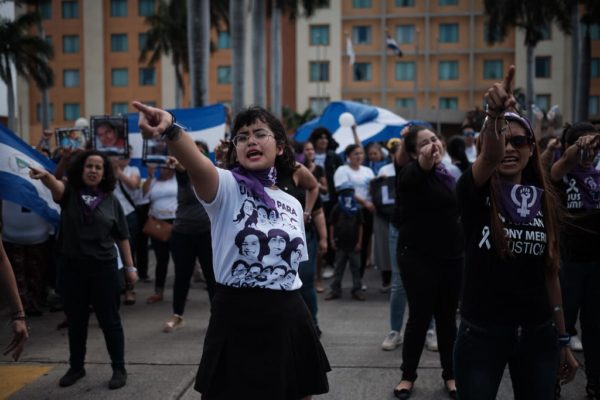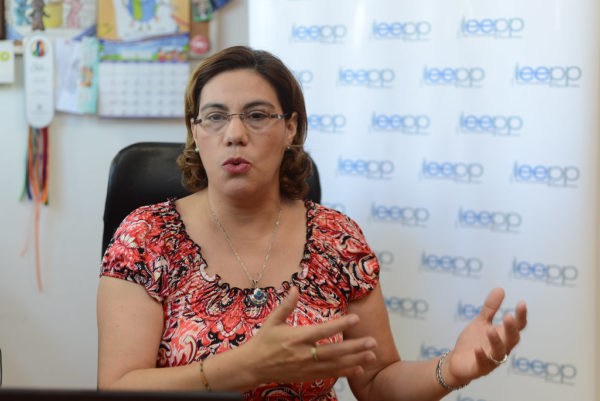Ortega Regime’s Ongoing Violence against Women
journalists, artists, academics and activists among the victims

There are currently 19 female political prisoners in Nicaragua, principally journalists, online activists, artists, and academics. All are being punished for refusing to bow down to the dictatorship of Daniel Ortega and Rosario Murillo.
HAVANA TIMES – Female academics, artists, online activists, journalists, cultural promoters, and critics in general have been the target of “a structured policy of repression” on the part of the Ortega government. That’s the conclusion of a report authored by researchers Arlen Alejandra Padilla and Elvira Cuadra from the Center for Central American Cross-disciplinary Studies (Cetcam).
The study, published in Spanish, is titled: Voz, Saberes, Cultura y Memoria. Resistencias y Resiliencias Colectivas de las Mujeres Nicaragüenses (“Voice, Knowledge, Culture and Memory: Collective Resistance and Resilience of Nicaraguan Women”). It accuses the regime of “retaliating” against these women “for challenging the socially imposed gender roles and stereotypes, in general as well as in specific areas.”
They’ve gone after these women in response to their participation in processes aimed at the democratic transformation of the country, especially after the social explosion of 2018. That’s one of the conclusions of the aforementioned think tank, based in Costa Rica and comprised of Central American researchers from different disciplines.
In an interview broadcast on the online television news show Esta Semana and published on the Confidencial website, Elvira Cuadra, Cetcam director, details the ways in which the government of Ortega and his wife lash out against Nicaraguan women, and the tactics the women have implemented for mutual protection against those attacks, both in person and digitally.
This investigation is based on interviews and focus groups involving some 30 women in Nicaragua and in exile. How much weight does the world of these women carry, when compared with women as a whole?
These are groups of women who face very specific forms of violence related to the exercise of their careers, intertwined with other characteristics. They tend to be young women, or elders, or women from Nicaragua’s Caribbean Coast region. In 2022, we carried out a study to give us the general panorama of [government] violence against women. We discovered that certain groups experienced particular types of violent actions. These groups – journalists, online activists, etc. – don’t represent significant numbers in relation to the rest of the population, but carry weight through the type of activity they engage in.
Is political violence also gender violence? In what sense is the violence that rural woman, political activists, or university students suffer unique or distinct?
It’s gender violence, but it’s also political violence. It’s gender violence because in Nicaraguan society there’s a system that reproduces generalized forms of violence towards all women. through images, representations, traditional gender roles and a series of behaviors. However, in relation to certain types of women, this violence acquires particular traits. For example, the gender stereotypes or preconceived notions about female journalists are not the same as those held about female artists or cultural promoters. A journalist told us: “My boss insisted that I had to be pretty and thin, because I presented the news.” In the case of the performing artists, they told us: “In the music field, they believe that women should only sing about romance, or motherhood, or similar topics. They don’t see us playing drums, for example, or other kinds of artistic interpretation or creation.”
Hate speech against women
In Nicaragua, there are constant denunciations of the regime’s oppressive policies and hate speech [against women], despite the fact that Ortega and Murillo boast of restoring the rights of the population, particularly of women. Do they engage in hate speech against women?
There’s hate speech against women in general, and there’s hate speech against specific groups. And not just speech, but an entire policy, a series of measures that amount to political violence against specific groups. We’ve seen, for example, how some well-known academics, intellectuals, and artists in Nicaragua have been punished, simply because they have not bowed their heads to the dictates of the regime. The same has happened with women journalists. Some of them who refused to bow down have experienced prison, exile, denationalization, forced displacement, threats, harassment and attacks – a series of violent actions aimed at subordinating them.
The majority of these women have had to leave the country and are now in exile in Costa Rica, the United States or other places where they continue being victims of violence. Do they have any protection under the asylum provisions of those countries?
Not necessarily. The mere fact of having to forcibly uproot yourself, leave Nicaragua, be expelled, declared stateless and have to remain in another place, is already a violent occurrence. Adding to that is the fact that the countries taking these women in, don’t always have adequate conditions for surviving and settling in, beginning often with the acquisition of legal immigration status. In many cases, the women arrive without documents, due to situations that those sitting behind the desks in immigration offices can’t comprehend.

One of the topics that the study highlights is related to online violence or the violence practiced through social media – discrediting, threats, etc. Who’s behind this kind of violence?
Behind the violence practiced online against women, especially female journalists and online activists, we can identify three kinds of perpetrators. The Ortega-Murillo regime, with its troll farms and other apparatus, is one of the principal figures, but they’re not the only ones. There are also men who constantly engage in that type of harassment and threats against women. And we should also be clear, this kind of violence is sometimes generated from within the very organizations that form part of the civic movement.
“Don’t leave anyone behind”
What’s the principal strategy for resistance to this violence? If the government offers no protection, is a public denunciation effective? How are the women defending themselves?
One of the most important strategies, perhaps the main one, is mutual accompaniment through the creation of networks, groups, links, or communities among women. This has been one of the fundamental elements the women all pointed to. It’s been especially vital for certain groups like the journalists, the activists and the arts community.
Further, as I’ve repeated over and over, in the previous investigation one of the participants told us: “we’re determined not to leave anyone behind.” That means grabbing each other by the hand and trying to stay together or to keep ourselves together. That’s the most important element: accompanying each other, giving each other strength. Then there are some slightly more specific strategies that each group follows. In the case of the journalists, some have come to an agreement and created their own information platforms. The artists have also created groups, collectives. Those from academia build communities linking those inside the country to those outside, and then integrate academic figures from the places where they arrive.
There are approximately 121 political prisoners in the jails of the Nicaraguan dictatorship, among them 19 women. They’re university students, Catholics, advocates for religious freedom, and also political activists. There’s a former member of the Liberal Constitutionalist Party (PLC), as well as the regional president the indigenous Yatama Party. What does this group of women represent within the framework of this State persecution?
The State has become a perpetrator of violence. Not through omission, as happens in other places, but through the direct exercise of violence. We’ve seen it playing this same role in past years, and constantly from 2018 to the present. When they make someone a political prisoner, they arrest them, lock them up and sentence them, to show the rest of society what could happen to them, and especially what can happen to women who dare to raise their voices.
One of the common elements for this group of 19 female political prisoners is that all of them have been accused of the “crime” of spreading fake news. In some cases, it was because they had a Facebook page, or posted on social media, or simply because they demanded the release of Monsignor Rolando Alvarez or the freedom for Catholics to hold religious processions. That’s a [government] crime against free expression.
Effectively. If you review the path women have traversed, especially that of the women’s movement in Nicaragua, and see that the women’s movement has been one of the most consistent, with one of the strongest and clearest voices, then you can also see it’s no coincidence that what the regime wants to do through these imprisoned women is to silence all women’s voices and strangle freedom of expression.





